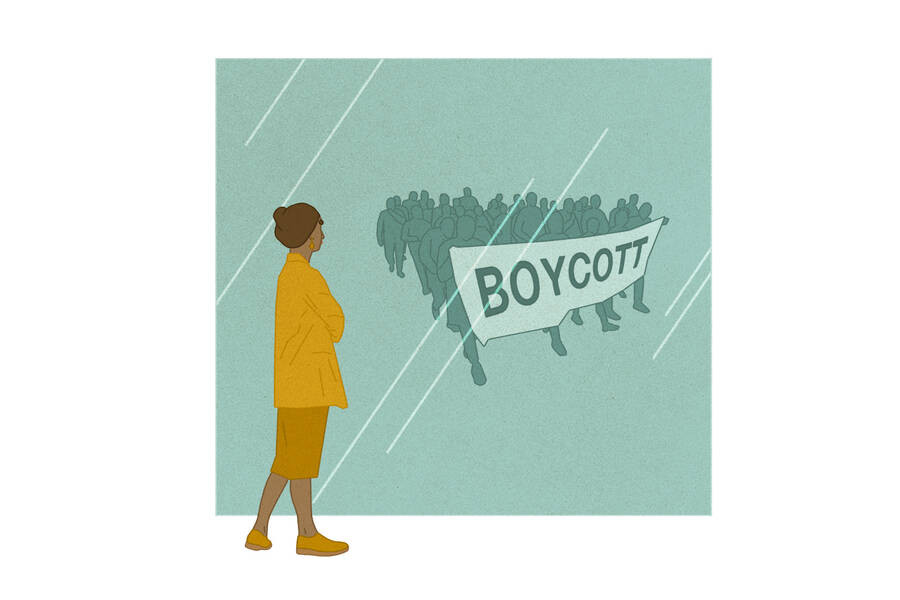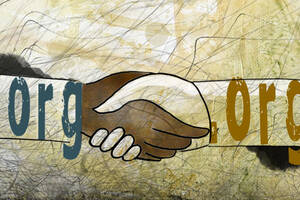What, then, is the impact of using these types of identifiers when movements are trying to gain allies? “Do these labels mobilize people, or do they actually cause a little bit of strife?” asks Cynthia Wang, a clinical professor of management and organizations at Kellogg. For people who already support the cause, the familiar words could energize them. But for those who are lukewarm, the labels could backfire.
In a new study, Wang and colleagues, including Brayden King, a professor of management and organizations at Kellogg, conducted online experiments to assess participants’ support for a hypothetical gender-equity policy at an organization. Among people who identified strongly as feminist, seeing the policy labelled as “feminist” boosted their support. But the opposite was true among people who didn’t consider themselves feminist.
For the latter group, a more effective strategy for gaining support was labelling the policy more generically with the target organization’s name. For instance, the proposed changes might be called a “Google policy” or a “Walmart policy.”
So activists might recruit more allies if they don’t stick to a movement-specific term. “You have to be a lot more flexible in the kind of language you use,” King says. “You can’t assume that all of your potential supporters are going to be feminists.”
But avoiding a label doesn’t mean avoiding social change. “We definitely are not telling people to be afraid of being an activist,” he says. It’s more about how to be “a smart activist.”
Looking Beyond CEOs
Social progress often involves pushing for new policies at organizations. For instance, activists might pressure a firm to release data on salaries of male versus female employees or to take measures to counteract gender bias in hiring. These calls for change can come from employees within the organization or from outside activists posting on an external platform such as Twitter.
Many past studies have focused on gaining the support of executives, Wang says. But she and King—along with Jennifer Whitson at UCLA Anderson School of Management and Rachel Ramirez Dubbireddi, then a graduate student at Kellogg and now at the United Parent Leaders Action Network—wanted to explore the challenge of getting employees throughout the organization on board. The CEO can tell people what to do, “but there still needs to be implementation,” Wang says. If staff members don’t agree with the changes, they might neglect new duties associated with the policy or push back.
“Real change requires high levels of support up and down the hierarchy of an organization,” King says.
From Negative to Neutral
To explore how people reacted to movement labels, the team set up experiments on the online platform Amazon Mechanical Turk. For the first study, they recruited 394 people who were currently working. Participants were asked a few questions to determine how strongly they identified as feminists.
Then they were asked to imagine that their organization had sent them an email announcing that the CEO wanted to implement a policy to improve gender equity. For half the participants, the email called it “a new feminist policy”; for the other half, it was simply called “a new policy.”
Then participants were asked how likely they were to take actions such as joining a task force, performing research on diversity practices, and openly endorsing the policy at a company-wide meeting. Based on their answers, each person was assigned a support score from 1 to 6.
As one might expect, people who strongly identified as feminists supported the policy more if it was labelled with the movement’s name. Their support score averaged 4.2 for the “feminist” policy and 3.9 for the unlabeled policy.
Among people who didn’t identify much with feminism, the effect was the opposite. Their support score averaged 3.1 if the policy was unlabeled and only 2.5 if the policy was called “feminist.” Similar patterns emerged in another experiment, in which the proposed policy aimed to address sexual harassment and was either unlabeled or described as “based on the principles of the MeToo movement.”
In both studies, the nonfeminists’ support for the unlabeled policy still wasn’t as high as the feminists’ support. But Wang notes that omitting the label seemed to push the first group from a negative to a neutral stance. While they weren’t gung ho about the changes, at least they might not have actively opposed them, she says.
Sloppy Execution
When a new policy is implemented, it often comes with a long list of tasks. A person’s support could be gauged not only by what they say about the changes but how effectively they perform these tasks. A person who doesn’t agree with the policy might do a sloppy job.
So could a new policy’s label actually affect how well people performed when they completed tasks associated with the policy?
To find out, the researchers ran an experiment in which 428 participants were given the names and departments of 22 hypothetical staff members who wanted to be kept informed about the gender-equity policy. Participants were given a company directory and for each department had to select those employees’ email addresses. The researchers then counted how many email addresses each participant had correctly added to the departmental lists.
People who didn’t consider themselves feminist performed better on the task when the policy was unlabeled, making an average of one fewer mistake in selecting the email addresses. Those improvements, added up over many employees at an organization, could have substantial collective benefits, Wang says.
Tapping into Company Pride
Finally, the researchers wanted to test whether an alternative label would garner more support from nonfeminists. One possibility was appealing to employees who identified strongly with the organization.
For this experiment, the team gauged participants’ feelings about their employer. For instance, people were asked whether they considered their organization’s successes to be their successes and whether they typically used the term “we” or “they” when talking about the organization.
Then the team presented the same email announcing a gender-equity policy—but for half the participants, the name of the organization the participant worked for was inserted. For instance, if the person worked at Starbucks, the email called it a “Starbucks policy.” For the other half of participants, the policy was called “feminist,” without the organization’s name.
Among people who identified strongly with their organization but not as feminists, their support for a feminist-labelled policy was 3.5. But when the name of the organization was attached to the policy instead, their support averaged 4.2. This score was even higher than the score for strongly feminist participants who didn’t identify much with their employer.
Triggering that organizational identity is “going to matter most for people who have very low identification as a feminist,” King says. “That’s where you’re getting the most bang for your buck.”
One Ally at a Time
Activists should consider the “micro-mechanisms” behind gaining allies, Wang says. “People often think about social movements as this grand thing,” she says. “But we also need to understand the psychology of the individuals that can help implement change, one person at a time.”
Some activists may balk at the idea of avoiding language that is such a core part of their movement. But King suggests thinking of change as two parallel processes. In public discourse, when activists are creating legitimacy for their cause, movement-specific labels can be important. But in individual conversations with people at an organization, activists may want to tailor their message to resonate with their audience.
The strategy is similar to those used by politicians who are trying to win broad support among voters or colleagues on the other side of the aisle. A Democrat would probably have better luck pushing through a new healthcare program if they emphasized that it “helped the middle class” rather than calling it a “progressive” or “left-wing” policy.
Similarly, activists may need to consider the political leanings of employees at the targeted organization. “You have to build a coalition,” Wang says. To do that, “you have to understand that sometimes certain language is going to be more appealing than other.”




